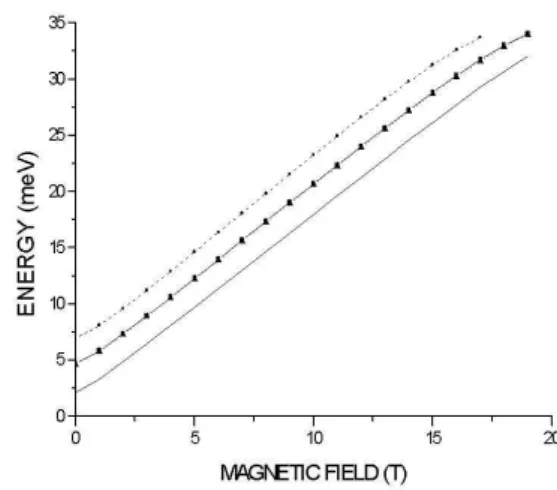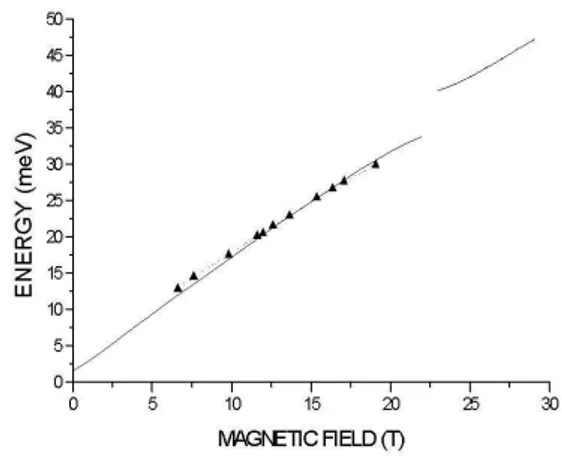354 Brazilian Journal of Physics, vol. 36, no. 2A, June, 2006
Magnetopolaron Effects on the Intradonor 1s-2p
+
Transition Energies in a
GaAs - AlGaAs Double Quantum Well
F. A. P. Os´orio∗, Paulo C. M. Machado†, and A. N. Borges∗#
∗Instituto de F´ısica, Universidade Federal de Goi´as, Caixa Postal131, 74001-970, Goiˆania, Goi´as, Brazil
†Escola de Engenharia El´etrica e de Computac¸˜ao, Universidade Federal de Goi´as,
Caixa Postal 131, 74001-970, Goiˆania, Goi´as, Brazil and
#N´ucleo de Pesquisas em F´ısica, Universidade Cat´olica de Goi´as, 74605-220, Goiˆania, Goi´as, Brazil
Received on 4 April, 2005
In this work we present a calculation of the intradonor 1s-2p+ transition energies for an impurity donor present in a GaAs-AlGaAs Double Quantum Well structure as a function of an applied external magnetic field. In our calculation the impurity energy levels were obtained from a variational method by choosing a Gaussian trial wave function, and the energy corrections due to the polaronic effect were included by second order perturbation theory IWBPT as modified by Cohn, Larsen and Lax. We have considered only the GaAs bulk LO phonon in the electron-phonon coupling. A very good agreement between the theoretical and experimental results for a
DQW consisting of two 100 ˚A well widths separated by a 100 ˚A potential barrier width was obtained.
Keywords: Intradonor 1s-2p+ transition; GaAs-AlGaAs Double Quantum Well; Magnetic field
I. INTRODUCTION
In recent years a great number of experimental works were devoted to the understanding of the nature of electron phonon coupling in doped GaAs heterostructures. These effects can be better studied in doped multiple quantum well structures (MQW) fabricated with low carrier density. As these systems are free of any screening process, they became extremely con-venient in order to investigate the electron-phonon interaction (polaronic effect).
Magneto-optical measurements of intra-donor 1s-2p+ tran-sition energies in doped GaAs-AlGaAs MQW were reported by several authors [1-4]. The kind of phonon present in the polaronic interaction was the main point of discussion. While some experimental works claim the observation of electron interaction with nonbulk phonons modes [1,2], other experi-mentalists claim that the electron interacts only with the bulk longitudinal optical (LO) phonon of GaAs [3,4].
Theoretical calculations treating the problem of a bound resonant magnetopolaron in GaAs structures were recently re-ported. Os´orio et al. [5-7] have calculated the intradonor 1s-2p+ transition energies as a function of the longitudinal mag-netic field for a center impurity in a GaAs single quantum well (SQW), and a good agreement with the available experi-mental data has been obtained when the electron- LO phonon coupling is considered. Similar conclusions were obtained in references [7,8]. A good agreement between the theoretical calculations of Os´orio et al. [6] with the available experimen-tal data occurs for an impurity placed inside the SQW. How-ever, for impurities located in the potential barrier, the fit to the experimental results is not so good. The SQW approximation cannot correctly describe the MQW samples.
In this work we present a calculation of the 1s-2p+ tran-sition energies for a donor impurity placed in a GaAs-AlxGa1−xAs double quantum well (DQW) structure in the presence of a uniform magnetic field applied in the DQW growth direction. The impurity levels are obtained through a variational method [6] and the electron-LO phonon
interac-tion effects are included in the calculainterac-tions by the Improved Wigner-Brillouin Perturbation Theory (IWBPT) as modified by Cohn, Larsen and Lax [10]. The calculations are performed for different positions of the impurity in the DQW and the conduction band non parabolicity effects are considered. The two level resonant process (1s-2p+) is considered and the be-haviour of the transition energies pinning in the phonon en-ergy is studied. Our results are compared with that obtained for a single quantum well (SQW) and with experimental data available.
II. THEORY
We consider a GaAs-AlxGa1−xAs DQW with a donor
impu-rity located in the barrier between the two wells at the position zI. A uniform magnetic field (B) is applied along the z direc-tion perpendicular to the wells interfaces. Within the frame-work of the effective-mass approximation, the Hamiltonian of an impurity bound electron in this system interacting with the GaAs-bulk Longitudinal-optical (LO) phonon is described by,
H = −∇2−2
rRp+γ
2ρ2
4 +γLZ+V(z) +
∑
~ kb~+ kb~k+
+
∑
~k
³
Vkei
~k.~rb
~k+Vk∗e−i
~k.~rb+ ~k
´
(1)
where the parameters are: γ= ~ωC
2~ω
LO, Rp=
³
Ry∗
~ω LO
´1/2
,and VK=|−~k|i
¡4πα
V
¢1/2
.ωCandωLOare respectively the cyclotron frequency and LO phonon frequency, R∗Y is the effective Ryd-berg (5,83 meV),α=0.068 is the Fr¨olich electron-LO phonon coupling constant, LZ is the z-component of the angular mo-mentum operator and b~k(b~+k)is the annihilation (creation)
op-erator of the k wave vector LO phonon.
F.A.P. Os´orio et al. 355
V(z) =
½
0 d/2<|z|<d/2+L
V0 d/2>|z| and |z|>d/2+L (2)
where d and L are the barrier-width and the well-width, re-spectively.
In the absence of the polaronic effect, we calculate the elec-tron binding energies of the impurity levels 1s, 2p−and 2p+, through the variational method as the Schr¨odinger equation for this system cannot be solved analytically. The trial-wave function we choose to describe the j state is,
ψj(r) =CjF(z)ρ|m|eimθexp
µ
−bjρ
2
2
¶
(3) where j=1,2,3 are for the levels 1s, 2p+and 2p−respectively corresponding to magnetic quantum number m=0,1,-1. Cj is the normalization constant, bjare the variational parameters, and F(z)is the standard wave function along the z direction for the electron in the ground state of a DQW given by,
F(z) =
D1eK2z z<−L1
−A4sinK1z+B4cos K1z −L1<z<−d2
C3(eK2z+e−K2z) −d2<z<d2
A4sinK1z+B4cos K1z −d2 1<z<L1
D1e−K2z z>L1
where L1 =d/2+L, K2= p
2mb(V0−E)/~2, and K1= p
2mbE/~2. mb is the GaAs electron effective mass and m2= (mb+0.083x) is the AlGaAs electron effective mass. D1, A4, B4, and C3are normalization constants. K1and K2are
determined by imposing the continuity conditions and current conservation at the interfaces of the wells. The j-level energy is obtained by minimizing the mean value of the unperturbed Hamiltonian Ej=
ψ
j
¯ ¯H
¯ ¯ψj
®
.
The displacement on the energies Ej due to the electron LO-phonon interaction effects was obtained by second order perturbation theory,
∆Ej=
∞
∑
n=0∑
~K|VK|2
¯ ¯ ¯hn|e
−i~K.~r|ji¯¯ ¯
Ej+∆j−En−1
(4)
where|n>and|j>are the eigenfunctions of the unperturbed Hamiltonian H, and the term∆j=∆Ej−∆E1introduces the
Improved Wigner-Brillouin Perturbation Theory (IWBPT). Note that for j=1 (m=0, 1s-level)∆j=0. This perturba-tion theory gives the correct pinning behavior in the weak coupling regime [11]. The summation over the eigenstates
|n>includes all donor states and makes impossible to evalu-ate it exactly. Here, we consider only the first three stevalu-ates 1s, 2p−and 2p+in the sum over n, following the work of Cohn, Larsen and Lax [9]. The equation (4) can be written as,
∆E= α 2πn
∑
=0Z d2K
K
¯ ¯ ¯hn|e
−i~K.~ρ|ji¯¯ ¯
Ej+∆j−En−1
FQ(K) (5)
where, FQ(K) is the quasi-two-dimensional form factor, which takes into account the dimensionality of the system in the z-direction,
FQ(K) =
Z
dz
Z
dz′|F(z)|
2
e−K|z−z′|¯¯F(z′) ¯ ¯ 2
III. RESULTS AND DISCUSSION
Our numerical results are for a GaAs-AlxGa1−xAs DQW structure consisting of two 100 ˚A quantum wells separated by a potential barrier with 212,6 meV (aluminum concentration x=0.3). The impurity donor is placed in the center of the po-tential barrier. We calculate the intradonor 1s-2p+ transition energies as a function of the applied magnetic field for several barrier widths.
Figure 1 shows the 1s-2p+ transition energies versus the magnetic field strength for a 200 ˚A single quantum well (SQW) (top dotted curves) and for DQW with 25- ˚A barrier width (intermediate solid + symbol curves) and 200 ˚A barrier width (lower solid curves). As expected decreasing the bar-rier width the transition energies for the DQW approximates the SQW result. For thin potential barrier the inner impurity position practically does not change the transition energy, this fact can be observed in Fig.1 where the intermediate curves show the results for two impurities position, in the middle and at the corner of the barrier.
FIG. 1: 1s-2p+ transition energies as a function of the magnetic field
strength for a 200 ˚A SQW (top curves) and for two DQW with
bar-riers widths 25 ˚A (intermediate curves) and 200 ˚A ( botton curve).
356 Brazilian Journal of Physics, vol. 36, no. 2A, June, 2006
a strong pinning of the transition energy occurs near the bulk-GaAs LO phonon energy.
FIG. 2: 1s-2p+ transition energy as a function of the magnetic field
for a DQW consisting of two 100 ˚A wells separated by a 100 ˚A
po-tential barrier. The impurity is located in the centre of the barrier.
For B>20T a resonant splitting of the transition energy is observed. The set of triangles shows the experimental results obtained by Huant et al. [4] for a MQW sample with the im-purities placed in the center of the potential barrier. The good agreement between the theoretical and experimental results only was possible when the transition energy was corrected by the conduction band nonparabolicity effect, included in the
calculation through the Palik expression [10],
ENPj =Ej(1−δ2
Ej EG
) +∆Ej (6)
whereδ2is the nonparabolicity parameter and EGis the GaAs gap energy. In this work we use the typical valueδ2=0.95
[10]. From this figure we can see that for impurities located in the potential barrier the effect of the MQW structure must be taken into account.
IV. CONCLUSIONS
In this paper we calculate the transition energies between the impurity donor levels 1s and 2p+ present in a GaAs-AlGaAs DQW structures as a function of an applied external magnetic field. In our calculation the impurity energy levels were obtained by the variational method and the energies crection due to the polaronic effect was included by second or-der perturbation theory IWBPT as modified by Cohn, Larsen and Lax. We consider only the GaAs bulk LO phonon in the electron-phonon coupling. A very good agreement between the theoretical and experimental results for a DQW consisting of two 100 ˚A wells separated by a 100 ˚A potential barrier was obtained.
Acknowledgement
We thank the Fundac¸˜ao de Apoio `a Pesquisa da UFG (FU-NAPE) and the Pr´o-reitoria de Pesquisa e P´os-Graduac¸˜ao da UCG (PROPE) for financial support.
[1] Y. H. Chang, B. D. McCombe, J. M. Mercy, A. A. Reeder, J. Ralston, and G. A. Wicks, Phys. Rev. Lett. 61, 1408 (1988). [2] J. P. Cheng, B. D. McCombe, G. Brozak, and W. Schaff, Phys.
Rev. B48, 17243 (1993).
[3] S. Huant, W. Knap, G. Martinez, and B. Etiene, Europhys. Lett. 2, 159 (1988).
[4] S. Huant, S. P. Nadja, W. Knap, G. Martinez, B. Etiene, C. J. G. M. Langerak, J. Singleton, R. A. J. Thomer, G. Hai, F. M. Peeters, and J. T. Devreese, Proc. 20thInternational Conference on the Physics of Semiconductor, Eds. E. M. Anastasakes, and J. D. Joanopoulos, World Scientific, Singapore, 1396 (1990). [5] F. A. P. Os´orio, M. Z. Maialle, and O. Hip´olito, Proc. 20th
Inter-national Conference on the Physics of Semiconductor, Eds. E. M. Anastasakes, and J. D. Joanopoulos, World Scientific,
Sin-gapore, 1017 (1990).
[6] F. A. P. Os´orio, M. Z. Maialle, and O. Hip ´olito Solid State Comm. 81, 8, 567 (1991).
[7] F. A. P. Os´orio, M. Z. Maialle, and O. Hip´olito Phys. Rev. B57, 1644 (1998-I).
[8] J. M. Shi, F. M. Peeters, G. Q. Hai, and J. T. Devreese, Phys. Rev. B44, 5692 (1991).
[9] G. Q. Hai, F. M. Peeters, and J. T. Devreese, Phys. Rev. B47, 10358 (1993).
[10] S. R. Cohn, D. M. Larsen, and B. Lax, Phys. Rev. B6, 1367 (1972).

